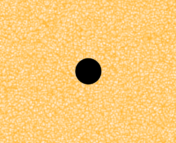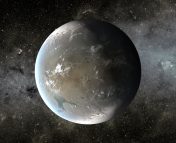Title: Stellar activity and planetary atmosphere evolution in tight binary star systems
Authors: C. P. Johnstone, E. Pilat-Lohinger, T. Lüftinger, M. Güdel, and A. Stökl
First Author’s Institution: University of Vienna, Department of Astrophysics, Vienna, Austria
Status: Accepted to Astronomy and Astrophysics, open access
Spinning companions
Compared to other stars, our Sun is rather unremarkable. It is near the center of our classification scheme, in the middle of its life, and kind of a loner, forming without any companion stars. As it turns out, the Sun’s solitary status may have allowed for life on Earth. Plenty of past work, fiction and nonfiction, has considered the possibility of life in multi-star systems, but today’s paper explores how the rotation and magnetic activity driven in a tight binary system might be severely detrimental to the habitability of nearby planets.
At the heart of this problem is rotation. Stars form from gas falling inwards under their own self gravity. In order to conserve angular momentum, all of that infalling gas needs to continue spinning, resulting in the characteristic rotation we see in protostellar disks. As a result, all stars begin their life rotating. However, they don’t spin forever. Stellar winds carry away angular momentum, especially through magnetic braking, causing the star’s rotation to slow down as it ages. The oldest stars are therefore spinning very slowly and we can reliably predict a star’s age by its rotation period.
Unsurprisingly, if you add a second star, the picture becomes more complicated. At a sufficiently close range the stars begin to exert tidal forces on each other. In extreme cases, the stars could even collide and merge. For the purposes of this paper, the authors are especially interested in the case where tightly orbiting stars can replenish their angular momentum by sapping energy from the binary orbit. Such a process would cause the orbit to grow tighter and tighter as the stars spiral inwards. As shown in Figure 1, this can result in models of stars that are kept rotating for longer or are even accelerated by quickly rotating companions.

Fig. 1 – Rotation rates and orbits over time for models of an initially slowly rotating star (red) and a quickly rotating companion (blue) for a variety of initial angular separations. When the orbits and rotation rates overlap, the stars are tidally locked with each other. All model stars in this work were Sun-like stars. Figure 2 in the paper.
One easy step to lose a planet’s atmosphere
Why should a star’s rotation rate matter for orbiting planets? While rotation by itself does not dramatically affect a planet’s evolution, the magnetic activity of a star can determine the fate of a new planet’s atmosphere. Rotation and magnetism are intricately linked by the star’s dynamo process, a mechanism that allows the conversion of rotational and magnetic energy. The models in today’s paper did not simulate the stars’ dynamos since dynamo theory is a thorny field by itself. However, the authors were able to use past work that linked a star’s Rossby number (a useful measure of rotation rate) to the X-ray and EUV emissions created by magnetic activity. In general, they found that decreasing the initial separation between the two stars resulted in an increase in total emitted energy. An important caveat is that if the stars begin too close, they eventually collide and merge and the total emitted power decreases.
High energy stellar emissions are quite adept at turning an otherwise habitable planet into a barren rock. It even happened to Mars in our own solar system. If a planet’s upper atmosphere is heated by violent solar activity, the gas will expand causing mass loss into space. The authors of today’s paper point to past work that finds that the mass loss rate is directly proportional to the amount of X-ray and EUV flux from a host star. With that information, the authors were able to model the atmospheric mass of an Earth-like planet orbiting two Sun-like stars over the life of the stars (Fig. 2). They found that the lifetime of a planet’s atmosphere strongly depended on the initial separation of the binary star pair. While decreasing the separation did not necessarily cause faster atmospheric extinction–remember that very tight binary orbits tend to result in collisions and less overall high-energy emission–the authors found that the emission from sufficiently tight binaries can efficiently strip away a planet’s atmosphere in almost all cases.

Models of the Earth-like planet’s atmosphere over time. Different colors correspond to different initial orbital separations for the binary pair, while the initial rotation speed of the two stars is described at the top of each plot. For each scenario, the authors consider three different initial atmospheric masses: 0.1, 0.01, and 0.001 Earth masses. Figure 8 in the paper.
Habitability is a rare feature in planets. Of the nearly 4,000 exoplanets discovered so far, less than 50 are potentially habitable. The planet needs to be made of the right material, the star needs to be the right type, and it needs to be at just the right distance from its host star. Today’s paper unfortunately reveals another avenue by which planets can be ruled out. Under the right circumstances, an otherwise hospitable pair of stars can spin each other into volatile, atmosphere-destroying hosts. And without an atmosphere, we certainly cannot expect a planet to host life.
Featured image from theconversation.com




